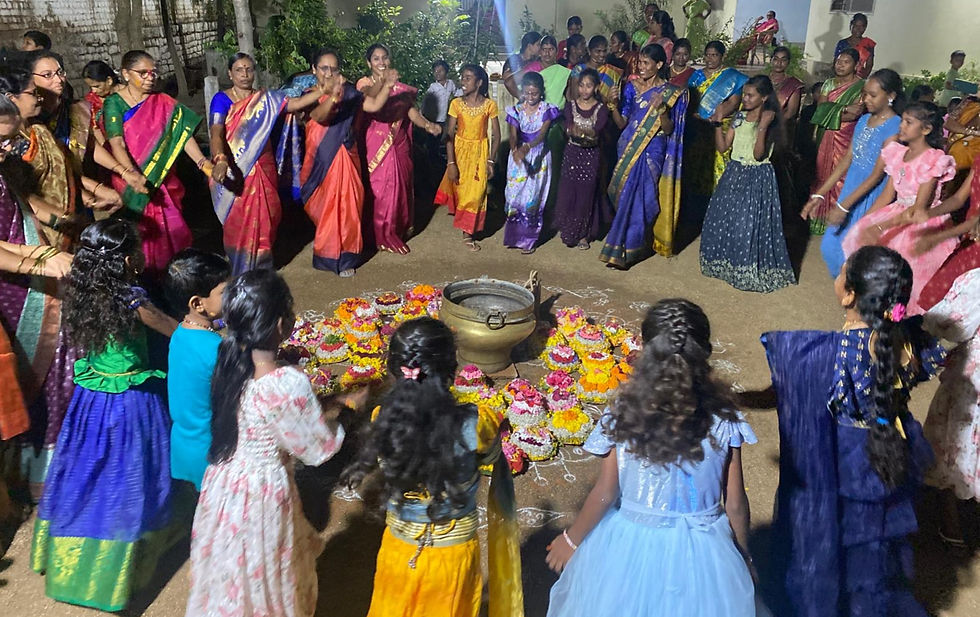Bathukamma, the colourful floral festival of Telangana, beautifully blends tradition, culture, and nature. Translating to "Live, O Mother" or "Mother, come alive," Bathukamma symbolizes hope, prosperity, and the rejuvenation of life. Celebrated over nine days during the lunar month of Ashvayuja, this festival marks the harvest season with the Kharif crop, with womenfolk coming together to craft stunning flower arrangements, sing traditional Janapada Geetaalu -folk songs, and honor the goddess. This festival begins on Mahalaya Amavasya and continues for 9 days during the Sharad Navratri.

Legends that led to this celebration:
The festival is steeped in intriguing legends that enrich its cultural significance:
King Dharmangudu and Queen Satyavati: This poignant story tells of a royal couple who lost all their children in war. In their despair, they prayed for a child and were blessed with a daughter named Bathukamma - “Live, O Mother” or you could even say “ Mother of Life”. The joy this child’s birth brought to their kingdom inspired the festival, symbolizing new life and hope after great loss.
The Rajarajeshwara Temple: Another intriguing tale links Bathukamma to the reknowned Rajarajeshwara Temple, constructed by the Chalukya kings in Vemulavada, Karimnagar district. According to this legend, the heir of Raja Raja Chola attacked the ruling kingdom and took the temple’s Brihat (large) Shivalinga as a tribute to his father. To console and comfort Goddess Parvati of her loss, the locals created flower mounds resembling Mount Meru, placing a turmeric mound on top to symbolize Gauri. They sang traditional songs and danced around these Bathukammas before immersing them in nearby waterbodies. Over time, this ritual evolved into the Bathukamma festival we celebrate today.
The Awakening of Devi: The final legend speaks of Goddess Durga entering a deep slumber on Ashwayuja Padyami after her fierce nine-day battle with the demon Mahishasura. On Dashami, the tenth day, villagers use medicinal flowers, traditional songs, and dances to awaken her, marking the day we celebrate her victory over evil—Dussehra.
The Art of Bathukamma
Creating Bathukamma is a beautiful art form that has been passed down through generations. The conical floral mound is carefully arranged or stacked on a brass plate, starting with gummadi aaku (pumpkin leaves) as the base. Layers of colorful, local flowers having medicinal properties are added, such as:
Thangedu puvvu (Tanner's Cassia)
Gunugu puvvu (Silver Cock’s Comb)
Ganneru puvvu (Nerium Oleander)
Tamara puvvu (Lotus)
Chamanti puvvu (Chrysanthemum)
Chitti Chamanti puvvu (Small Chrysanthemum)
Banthi puvvu (Marigold)
Gaddi Chamanti puvvu (Tridax Daisy)
Katla puvvu (Sky Blue Cluster flower)
Rudraksha puvvu (4 o’clock flower)
Gilledu puvvu (Crown Flower)
Challagutti puvvu (Stick Bush)
Kasiratnam (Morning Glory Flower)
Nandivardhanam (Butterfly Gardenia)
Mandara (Hibiscus)
Gaddi puvvulu (Sedge)
Teku puvvu (Teak Flower)
Additionally, gummadi puvvu and aaku, beerakaya puvvu (ridge gourd flower), dosakaya puvvu (yellow cucumber flower), and an assortment of malli puvvu (jasmine), kadambaram (Kadamba flower), and maruvamu (Marjoram leaves) are used to enhance the beauty and significance of Bathukamma. These flowers not only adorn the festival but also carry medicinal properties, purifying the water when the Bathukamma is immersed in the local water bodies.

Each night of Bathukamma is marked by unique offerings known as naivedyam (prasad). The names of the different Bathukamma offerings include:
Engili Puvvula Bathukamma
Atkula Bathukamma
Muddapappu Bathukamma
Nanbiyam Bathukamma
Atla Bathukamma
Aligina Bathukamma
Vepakaya Bathukamma
Venna Mudda Bathukamma
Saddula Bathukamma
These culinary delights reflect the seasonal harvest and are prepared using locally grown ingredients. As communities gather to sing and dance , Bathukamma becomes a joyous occasion for all, fostering sisterhood and unity that transcends caste barriers.
On Vijaya Dashami, the festival culminates with prayers to the Jammi tree (Prosopis cineraria). Families dance around the tree, then pluck the leaves offering to elders to take blessings.
Bathukamma is more than just a festival; it’s a celebration of life, community, and nature. By participating in this tradition, we honor our roots and promote cultural learning for future generations. This festival is a reminder of the agricultural heritage while strengthening the bonds within communities.

Comentários